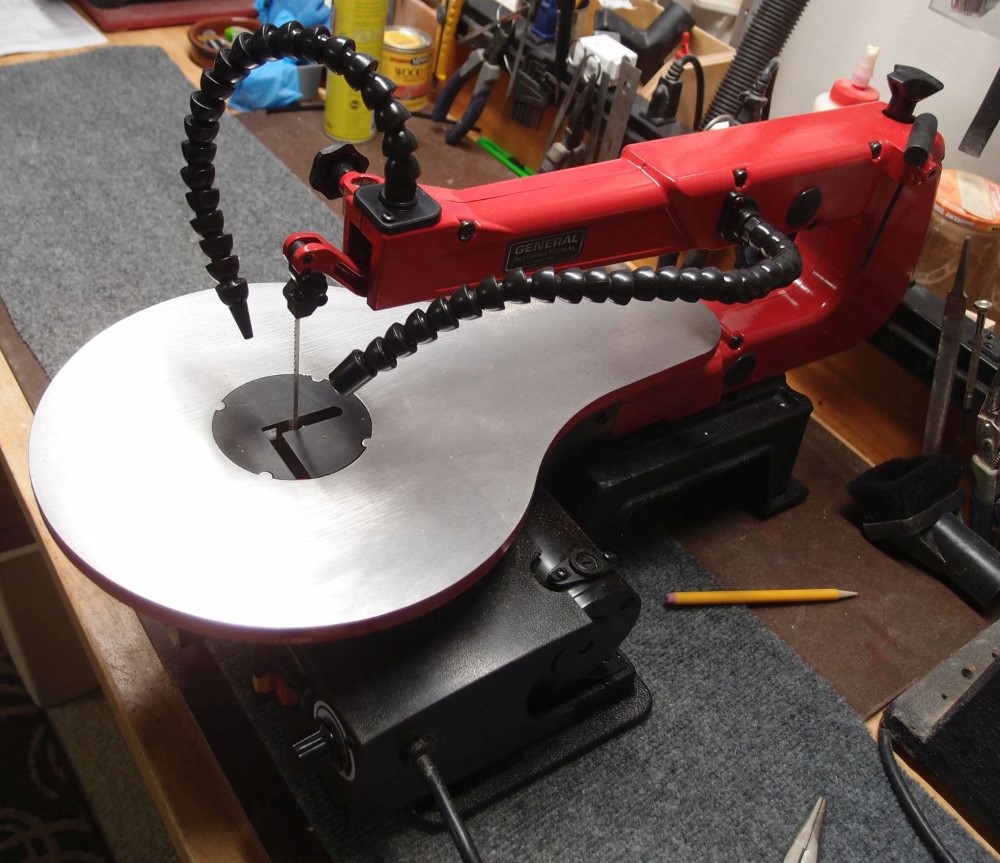July 17, 2020
A Decent Scroll Saw
July 17, 2020

General International 1.2 Amp 16 in. Variable Speed Scroll Saw with Flex Shaft LED Work Light
This is another piece that I got for free for review. Normally it is about $90. I would have soldiered on forever with my ancient Craftsman saw because I am cheap, but free is free and even better than cheap, and this is a nice upgrade. Compared to my antique model, this saw is variable speed, easier to change blades and takes both kinds, adds a work light, dust blower and dust port, and is lighter with a bigger table.
First, I noticed the blade was slightly out of kilter, which is not unexpected. I squared the table to the blade, and then adjusted the angle pointer to match. The table surface felt a little rough, so I smoothed it down with 1000 grit sandpaper, especially the edges. Finally, I removed the 'blade guard', which I really don't need. The dust blower and light are separate from the blade guard. The dust port is typical, whether it fits anything you have is pure chance, I wish there was a standard for these things, but there isn't.
Blade changes are easy with the included wrench, and the lower blade mount is easily visible through the table when you take out the insert. The blade wrench stores conveniently in a socket at the back of the saw. There is a little compartment at the side where you can store extra blades and the wrench for the blade guard. There is also a little tray where you can keep ready spare blades.

Feature-wise, this saw is a big win over my ancient one. Variable speed is what I really wanted. The fixed-speed saw works fine on wood, but tends to melt plastic. Often, the plastic flows back together behind the blade and re-joins, and if you stop, it will solidify around the blade and you can throw the whole thing away, blade and all. This saw can slow down to 400 rpm, which is slow enough to cut even difficult clear plastics without overheating. The slow speeds are also nice if you are doing fine work and don't need a screaming banshee of a saw. At the other end of the speed scale, it cut 2 inch hard pine with little trouble and no bogging down, which my old saw was very prone to.
I noticed the instructions talk about oiling the arm bearings. My old saw has the same kind of bronze bushings, and I doubt they have ever been oiled or needed it; I have the old instructions and they make no mention of it. At any rate, putting few drops of oil on now and then is no big deal.
Looking at pictures, this saw is basically identical to a number of other brands. All these saws have identical major components, like the base casting, table, arm assembly, motor etc. They differ only in details like blade mount, knobs and color. Clearly all made to the same design in China, if not in the same factory. Compared to its siblings, this saw is lower-priced and superior in a number of details like the dust blower. If they were all next to each other, I would pick this one.

My one peeve is that the on/off switch is mounted sideways and out of sight below the table. It should be up and down, so you swipe up for on and down for off, like everything else. Sideways was a lot of fumbling, so I fixed it - the cover plate is plastic and I cut out the hole for the switch and re-mounted it. Then I closed up the openings with some scrap binding so it almost looks factory.

